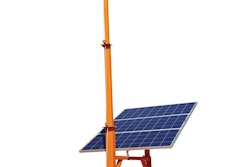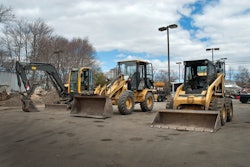As soon as the construction season starts to gear up, equipment and materials begin to mysteriously disappear from many projects. Left unattended, they are potentially lucrative targets for those “enterprising” types who always seem to be lurking around jobsites.
In addition to mobile equipment (backhoe-loaders, skid steers, compact excavators, generators, etc.), commonly stolen items include lumber, bricks/pavers, wire, cable, rebar and even large steel beams. Essentially, anything left out in the open, unlocked or unguarded has become fair game.
As construction activity grows, and material costs along with it, the problem of theft is very likely to get worse. Estimates show losses anywhere from $300 million to $1 billion per year from construction equipment theft alone. Add in the costs of material theft, the expense of project delays, replacement costs and insurance premium increases, and the total costs are exponentially higher.
To minimize the risk of losses from your sites, it’s important to have a theft prevention plan in place. Prior to starting a project, identify any items that could be at greatest risk. Then work with field employees to identify ways to make a thief’s job more difficult. Common tactics include:
- setting up additional lighting around the site at night;
- installing fencing and security cameras around the perimeter of the site, if possible;
- elevating smaller equipment out of reach and/or circling large machines around smaller units, piles of rebar, etc. to prevent easy access;
- keeping small equipment, tools and materials under lock and key, then parking heavier machines in front of the storage facility to minimize the risk of break-in;
- investing in equipment lock-out devices, or keyless control systems that require individual pass codes to start the machine;
- notifying police of the hours of activity on the site and, in high-crime areas, hiring security to patrol during off hours.
As part of your plan, establish theft prevention policies and communicate these policies to all workers. Make sure they understand their responsibilities for securing the equipment and/or site at the end of the work day or shift.
Even the best prevention measures don’t always work, so take steps to make it as easy to recover equipment and materials as possible. Where feasible, stamp an ID number in both an obvious and a hidden area. Consider painting equipment in unique or easily identifiable colors with the corporate logo clearly visible.
Develop a list of equipment serial/product identification numbers. If possible, maintain a file of color photos and notes with other identifying information. Check into registering your equipment with the National Equipment Register (http://ner.net) or a similar organization.
If your budget allows, consider installing stolen equipment recovery or equipment tracking (telematics) systems on high-value equipment. In addition to monitoring its location, many telematics systems allow you to establish authorized hours of operation and/or an operating perimeter (geofence) for the machine. If the equipment is started up during non-authorized hours or leaves the geofence area, an alert is issued warning you of the event. Some applications will automatically immobilize the equipment to prevent its use.
Theft from construction sites has become big business. By taking a proactive approach, you reduce the chance of becoming its latest victim.




















